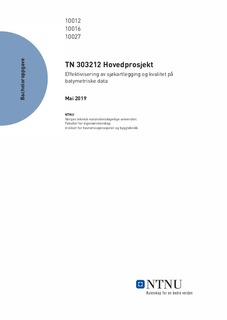| dc.description.abstract | Det ferdes årlig flere tusen fartøy langs norskekysten og en av forutsetningene for at fartøyer kan seile sikkert er gode sjøkart med nøyaktige dybdedata. Situasjonen i dag er at store deler av dagens kartgrunnlag strekker seg tilbake til starten av 1900 taller og er oppmålt med utdaterte metoder. Ettersom trafikken langs kysten er stadig økende, med et trafikkbilde som i større grad ferdes utenfor hovedledene, kan man si at behovet for nøyaktige sjøkart er økende. Dette står i kontrast til kartverkets prioritering av kartlegging av hovedledene langs kysten og sideleder er ofte ikke kartlagt med moderne metoder. Dersom man setter dette i sammenheng med utgivelsen av nye sjøkart, estimeres det at det vil ta opp mot 130 år å samle inn og publisere data med dagens tempo. Ut fra dette kan man utvilsomt se et behov for å effektivisere kartleggingsprosessen i Norge.
Gruppen har i denne oppgaven sett på hvilke muligheter som eksisterer for å effektivisere og avlaste kartverkets arbeid. Gruppen har tatt syn på å beskrive utfordringer knyttet til regelverk, krav til nøyaktighet og autorisering i tillegg til plattformer og metoder som kan være aktuelle. I tillegg har gruppen i arbeidet med oppgaven hatt tett kontakt med kartverket og andre relevante aktører. Dette har ført til at oppgaven kan anses for å ha en bred faglig forankring innenfor sitt segment.
For å kunne belyse flere muligheter har gruppen valgt å beskrive tre ulike alternative metoder. Oppgaven omhandler følgelig muligheten for innsamling av dybdedata ved hjelp av crowdsourcing, autorisering av private aktører samt bruk av autonome plattformer til innsamling av dybdedata. Gruppen har i arbeidet med oppgaven avdekket at det allerede i dag vurderes å ta i bruk noen av metodene gruppen har beskrevet. Som eksempel kan det her nevnes at har blitt et stort internasjonalt fokus på mulighetene innenfor crowdsourcing for eksempel gjennom bruk av offentlige databaser med slike data. Samtidig har det også blitt mer aktuelt for private selskaper å søke autorisering av kartverket de siste årene. Dette fordi markedet for slike selskaper er i vekst på grunn av økende etterspørsel etter nøyaktige batymetriske data. | |
| dc.description.abstract | Several thousand vessels sail every year along the Norwegian coast, and one of the safety criteria for these vessels are nautical charts with accurate depth data. The current situation is that most of the depth data used in existing charts originates from the start of the twentieth century and was collected using outdated methods. Seeing as the traffic along the coast is increasing, with more and more vessels sailing outside of the main fairway, one could say that the needs for accurate nautical charts are increasing. This contrasts to the Norwegian Hydrographic Service prioritizing the surveying of the main fairways, and as a result, alternative fairways have often not been surveyed using modern methods. If one compares this to the publishing of nautical charts, it is estimated that it will take up to 130 years to survey and publish depth data at the current pace. Consequently, one can clearly see that there is a need to streamline this process in Norway.
In this thesis, the group has examined which possibilities exist currently, to alleviate the work of the Norwegian Hydrographic Service. The group has chosen to describe the challenges related to regulations, precision requirements and authorisation as well as methods and platforms that may be relevant today and in the near future. Additionally, the group has had close contact with the Norwegian Hydrographic Service as well as other relevant organizations and companies. This has resulted in a thesis that may be considered as being anchored broadly within its segment.
In order to describe several possibilities, the group has chosen to describe three different streamlining alternatives. As such, within this thesis is described the possibilities of depth surveying using crowdsourcing, authorizing of commercial companies, as well as using autonomous platforms. In writing this thesis, the group has discovered that some of the abovementioned methods are being considered by a several of organizations. As an example, there is a considerable international focus on the possibilities of using crowdsourced bathymetric data in the publishing of nautical charts, perhaps using a central database containing such data. Additionally, the authorizing of private companies has become highly relevant in later years. This is especially due to the increasing demand of accurate bathymetric data. | |
